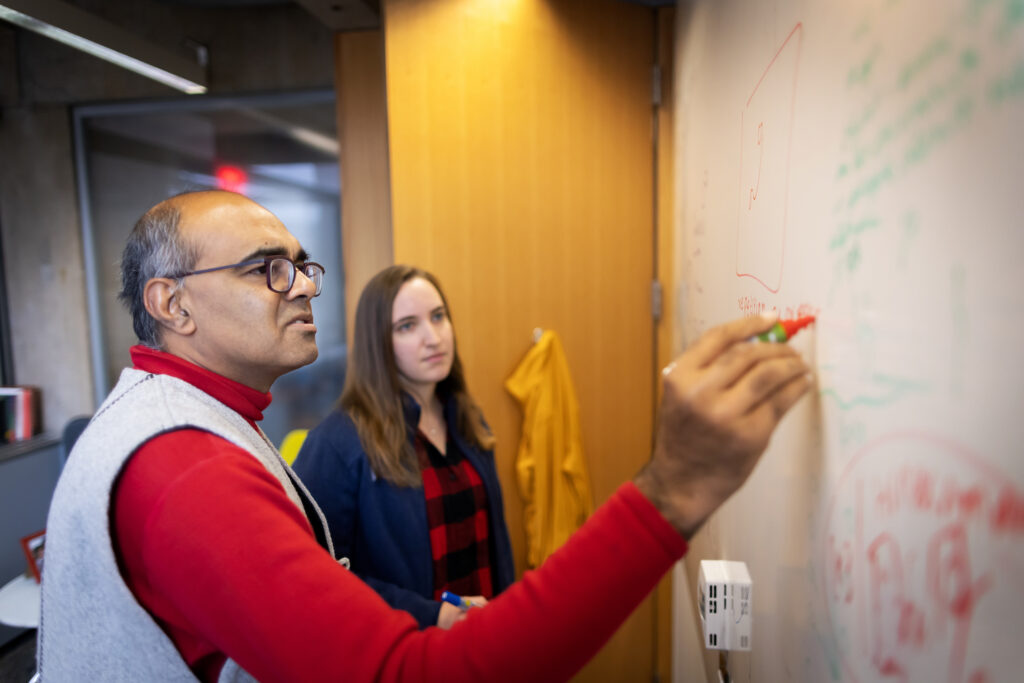
Academia is a long journey of specialization and behind any professor’s CV are long hours of research and study. While the path can be direct for some, for others there’s a pivot, a moment or experience that changes the course of that journey.
Penn Today spoke with four professors whose academic paths diverged, to learn about the trajectory of their interdisciplinary work. Vijay Balasubramanian traverses the boundaries of physics and neuroscience. Tukufu Zuberi is a demographer-turned-curator. Brittany Watson integrates education, research, and veterinary medicine. Amy Hillier began her career studying historical mortgage redlining and moved into supporting trans youth.
Vijay Balasubramanian
The Cathy and Marc Lasry Professor of Physics in the School of Arts & Sciences
Wandering through Kolkata’s markets in India stimulates the mind. Hawkers’ cries pass through the inner ear as electrical signals; the pungent, earthy smell of turmeric enters the brain through olfactory sensory neurons. In 1976, a 7-year-old Vijay Balasubramanian had his own market revelation through a bookseller’s portico, where the cover of a slim volume showed a man peering through a microscope lens and a smattering of white paint scattered like stars across the firmament of man and machine.
“What is a scientist?” the book asked, running through a series of exciting adventure shots: archeologic discovery, venom extraction, missile control. In that moment, Balasubramanian knew he would be a scientist. It looked, he says, “amazingly cool.”
When he arrived at the Massachusetts Institute of Technology, Balasubramanian wanted to study the fundamental laws of nature. “So that’s physics,” he says. While earning his doctoral degree at Princeton University, a mentor suggested Balasubramanian read papers in the burgeoning field of neuroscience. It immediately resonated. “Oh my god, this stuff is so cool,” Balasubramanian thought. “But the final year of a Ph.D. is not the time to switch.”
He earned his degree and took a position as a junior fellow of the Harvard Society of Fellows. During the day, he worked on string theory and the information loss paradox for black holes. But in the evening, he would moonlight in a neuroscience lab.
As a young theoretical physicist at Penn, Balasubramanian met Peter Sterling. A former Freedom Rider and professor of neuroscience at the Perelman School of Medicine, Sterling was “a true intellectual,” Balasubramanian says. He knew everything, was interested in everything, and would talk with anybody.
The pair wrote a series of papers together regarding information processing and transmission. “He’s so quick and so much fun and so lively,” Sterling says of Balasubramanian. “He’s fearless; there’s nothing he won’t try.”
While in Cairo with wife Heather J. Sharkey, professor of modern Middle Eastern and North African history at Penn, Balasubramanian prepared a neuroscience grant and submitted it to the National Science Foundation, “sort of on a whim,” he says. “I put it in from an internet café on an island in the middle of the Nile.” He got the grant and started a research group.
After that, Balasubramanian says, “I was off and running.”
“I was certainly told,” Balasubramanian says of his work in neuroscience, “do not do this before tenure.” But, if he waited, “then I’d be too set my ways,” he says. “I just wouldn’t know enough; it would be too hard to learn; I wouldn’t have the time.”
Younger scientists often ask him about exploring multiple fields, Balasubramanian says. The advice he offers is to “have a central line where you have credibility, where you’ve established that you’re really, really good at what you do, and you can be trusted.” That gives you more latitude, he says.
After that, it’s just sheer discipline. “You’re going to have to wake up earlier than everybody else. You’re going to have to work longer days,” he says. “Otherwise, you know, everybody else is working hard too, and you’ll never be able to achieve the level of expertise and knowledge to be able to do things at that world-class level.”
Balasubramanian wants to see more interdisciplinary collaboration. “Each field trains its students with a certain body of techniques that has been found historically useful in that field,’ he says. “Very often, those techniques also have uses elsewhere, but they don’t know to apply it.”
Traversing borders can be helpful in producing new insights, Balasubramanian says. You can ask questions that people in the field won’t. You might experiment with new ideas or put two disjointed ideas together, he says. “If you’re coming from outside, you have the leeway to do all kinds of silly things. Sometimes, they’re not silly.”
Why not ask new questions and propose new answers? In the end, the data will tell you what’s true. “It gives me comfort to know how things tick.”
This post is adapted from a longer story in Penn Today. Read the full story here.
Balasubramanian is Cathy and Marc Lasry Professor in the Department of Physics and Astronomy in the Penn School of Arts and Sciences and is a member of the Penn Bioengineering Graduate Group. Read more stories featuring his research here.
